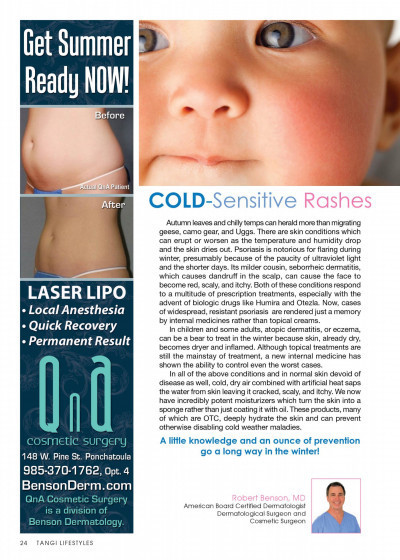COLD-Sensitive Rashes

Autumn leaves and chilly temps can herald more than migrating geese, camo gear, and Uggs. There are skin conditions which can erupt or worsen as the temperature and humidity drop and the skin dries out. Psoriasis is notorious for flaring during winter, presumably because of the paucity of ultraviolet light and the shorter days. Its milder causing, seborrheic dermatitis, which causes dandruff in the scalp, can cause the face to become red, scaly and itchy. Both of these conditions respond to a multitude of prescription treatments, especially with the advent of biologic drugs like Humira and Otezla. Now, cases of widespread, resistant psoriasis are rendered just a memory by internal medicines rather than topical creams.
In children and some adults, atopic dermatitis, or eczema, can be a bear to treat in the winter because skin, already, dry, becomes drier and inflamed. Although topical treatments are still the mainstay of treatment, a new internal medicine has shown the ability to control even the worst cases.
In all of the above conditions and in normal skin devoid of disease as well, cold, dry air combined with artificial heat saps the water from the skin leaving it cracked, scaly, and itchy. We now have incredibly potent moisturizers which turn the kin into a sponge rather than just coating it with oil. These products, many of which are OTC, deeply hydrate the skin and can prevent otherwise disabling cold weather maladies.
A little knowledge and an ounce of prevention go a long way in the winter!
Robert Benson, MD
American Board Certified Dermatologist
Dermatological Surgeon and Cosmetic Surgeon


